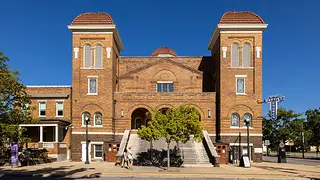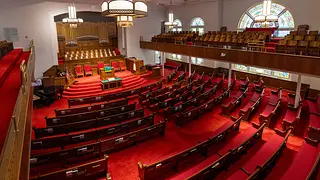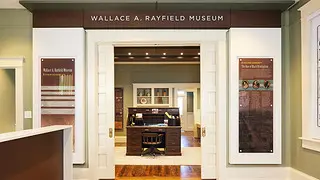Built to Last: The Living Legacy of the Sixteenth Street Baptist Church
The Sixteenth Street Baptist Church is a 2024 recipient of the Trustees Emeritus Award for Historic Site Stewardship, which recognizes success and innovation in historic preservation, management, and programming at historic sites.
A sacred symbol of the Civil Rights Movement, the historic Sixteenth Street Baptist Church in Birmingham, Alabama is a place of worship, resilience, and remembrance that continues to open its doors to more than 100,000 domestic and international visitors annually. In recent years, the Church undertook an ambitious restoration and expansion project to safeguard its historic fabric while reimagining how it can engage thousands of tourists through programming and a multimedia museum space that encourages dialogue, education, and social justice. Support from the Birmingham community, national and corporate partners (including the National Trust's African American Cultural Heritage Action Fund's Preserving Black Churches program and National Fund for Sacred Places), and a small but determined congregation made this monumental effort possible.
The following Q&A is with Reverend Arthur Price who serves as Pastor of the Sixteenth Street Baptist Church. Learn more about the full slate of 2024 awardees here.

photo by: Lynsey Weatherspoon
Exterior of the Sixteenth Street Baptist Church in Birmingham, Alabama.
Sixteenth Street Baptist Church holds a profound place in American history. Can you share its historical significance, particularly its role during the Civil Rights Movement, and its impact on the nation?
Sixteenth Street Baptist Church is the oldest African American Baptist church in Birmingham proper. It was organized in 1873, ten years after the Emancipation Proclamation was signed by President Lincoln. What makes our church significant is that W.A. Rayfield, the second licensed African American architect in the country, designed the church. It was designed by a Black man. It was built by a Black building company and paid for by Black people.
Sixteenth Street Baptist Church had a dual role in the Jim Crow South. It was a place of spiritual formation and a place of social recreation because you couldn't go to a lyric theater or an Alabama theater or a Birmingham Convention Center. They had to bring people to the Sixteenth Street Baptist Church in order to hear them. Booker T. Washington, W.E.B. Dubois, Mary McLeod Bethune, Marian Anderson, Ralph Bunche, Paul Robeson, and Jackie Robinson all spoke there. The list goes on and on. The most noted speaker is, of course, the Reverend Dr. Martin Luther King Jr., who was brought to Birmingham in 1963 by Reverend Fred Shuttlesworth.
Stay connected with us via email. Sign up today.
It was 18 days after the march on Washington, after Dr. King said he had a dream, that the response in Birmingham was to bomb the Sixteenth Street Baptist Church because it was deemed to be the epicenter of the mass movements during that time. On September 15th, 1963, a bomb went off right after the Sunday school hour. The Sunday school lesson that day was a love that forgives. Four girls lost their lives. A fifth girl in the bathroom was blinded in one eye.
That bombing galvanized a generation, so much so that the leaders during that time wanted to make sure that their deaths were not in vain. They were assured that the Civil Rights Act would get passed in 1964 and that the teeth of the act, the Voting Rights Act, passed in 1965.

photo by: Lynsey Weatherspoon
Restored sanctuary of the Sixteenth Street Baptist Church.
This church continues to host an active congregation, but it also welcomes thousands of tourists. Maintaining a site of such profound historical weight must be challenging.
The challenge is always how to juxtapose ministry versus museum, to get people to see Sixteenth Street Baptist Church as a living ministry and not just a relic from the past that you come and pay homage to and leave. What we’ve done is incorporate the museum piece as a part of our ministry.
The other challenge is that we have a very old building that needs a lot of love and care. Our congregation is not a very large congregation– we have less than 500 members—but I say we have a mega ministry because of the eyes that are on us and the tens of thousands of people that come to see us. We have a mega ministry that does not just reach the Birmingham community, but also the global community, so the challenge is to make sure that the church never gets into a place where we defer maintenance. Of course, that takes funding, so we've had some capital campaigns in the past to shore up the foundation.
With our preservationists, architects, and other partners, we were intentional in how we design the experience that you're going to have. When we talk about partnerships, we’re talking about the Civil Rights Institute, the National Park Service, the National Trust—but we’re also talking about our educational systems. We have school groups that come to study how sacred places promote justice and compassion and leave with answers for the communities of which they live.
People see the Church as the community's church, and they have buy-in on preserving it because they want to make sure that this church stands for generations to come. They understand the significance of the church not just in Birmingham's history, but in America's history, and in the world's history.

photo by: Architecture Works
Repurposed basement for the Wallace A. Rayfield museum at the Sixteenth Street Baptist Church.
As a reverend, what has been the most rewarding aspect for you personally?
Rewarding for me personally is seeing the interest that so many people still have in the Sixteenth Street Baptist Church—not only just coming to the Church to learn about Dr. King, Dr. Shuttlesworth, or the four little girls, but coming to the Church for worship. The fact that we are still able to maintain our Church as a place of worship and to be able to give tours brings me great joy.
It could be easy to say, you know what? We'll close our doors, make this church a museum, and we could build another structure of worship. But to have this building still standing after all these years and still do what it was set out to do? The resilience that the church had through all these years is remarkable.
We've been around for 151 years. There is a whole lot of things that have come and gone, but the Sixteenth Street Baptist Church is still here because I believe we are a church that was built to last.
Donate Today to Help Save the Places Where Our History Happened.
Donate to the National Trust for Historic Preservation today and you'll help preserve places that tell our stories, reflect our culture, and shape our shared American experience.



